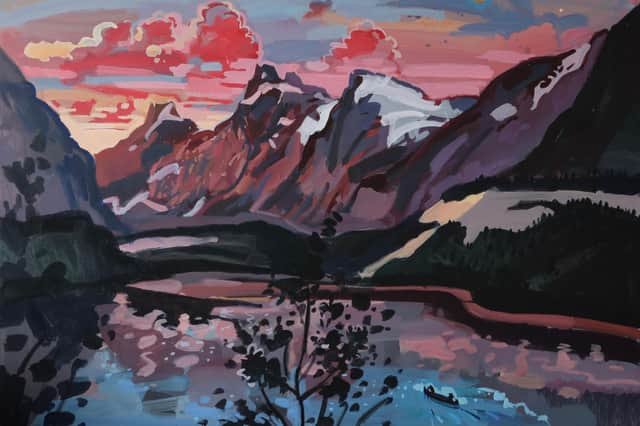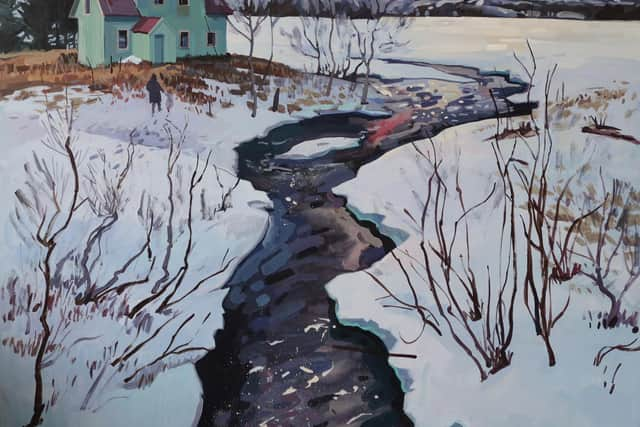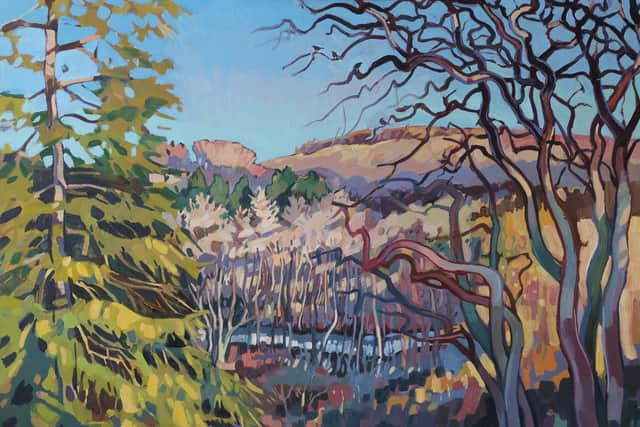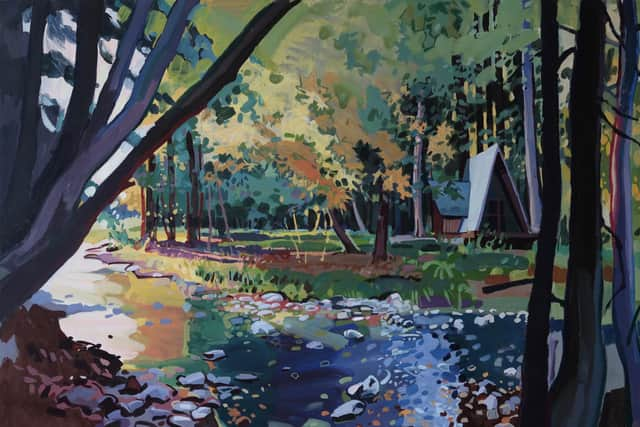Art reviews: Lachlan Goudie | Aleksander Zyw | David Forster


Lachlan Goudie: Once Upon a Time, The Scottish Gallery, Edinburgh ****
Aleksander Zyw: Before and After, The Scottish Gallery, Edinburgh ****
Advertisement
Hide AdDavid Forster, The things which they enjoy in life, Open Eye Gallery, Edinburgh, ****


Lachlan Goudie is a familiar face on television. He’s a painter but he has become a bit of a television personality too, not just with his series on Scottish art and several other documentary programmes, but also as the gentle tutor in Life Drawing Live! on the BBC, a sort of Prue Leith for art perhaps. He has not given up his day job however. Indeed he clearly has been very busy for there are more than 60 works in his current show at the Scottish Gallery and some are quite big. Many were painted during the long spring lockdown when he and his family were sequestrated in the Dorset countryside. Like many people, I think, he found it hard to concentrate at first, but the beautiful spring, his two little daughters’ enjoyment of it and the fairy stories he read particularly to his older daughter Clementine led him to paint it all and to call his show Once Upon a Time. Clementine appears to have spent a happy time dressed as Elsa, the princess from Frozen, and Fairy Tale, the cover picture for the catalogue, shows her in red wellies in a sunlit garden. Then, however, the picture is framed like an illustration of a Victorian book of fairytales with a border of irises, crows and, at the bottom, a sneaky fox against a red sunset.
It is not all fairy stories by any means, however. Last year Goudie visited the Lofoten Islands inside the Arctic Circle and there is more than a little bit of "once upon a time” about their landscape too. It’s the landscape of Frozen and of the Snow Queen, one of his daughter’s favourite stories. In The Frozen North and North Mountains, he paints a world of jagged mountains, ice and snow and the fox sneaks into the latter picture too. It is not simply a world of black and white however. In Arctic Palace and the Lost World the setting sun paints it all scarlet.
In February of this year, just before everything came to a grinding halt, Goudie and his family also spent time at Abbey St Bathans in Berwickshire. It was a bit of pilgrimage because it is near Cockburnspath where in 1883 his hero James Guthrie painted his early masterpiece, The Hind’s Daughter. Fittingly Goudie too painted some particularly lovely pictures there including A Berwickshire Landscape and The Huntsman’s Cottage. They both record the rich colours of the Scottish winter landscape. Here, however, Goudie has misled himself. In a brief note in the catalogue, he remarks that the Glasgow painters saw this landscape as monochromatic and dealt with it tonally. Contradicting them however, his east coast predecessor, James McIntosh Patrick, was wont to remark, “I canny paint summer. There’s nae colour.” In his own painting, however, Goudie has followed his eyes (and McIntosh Patrick) and not his text, and has painted the subtle brilliance of winter colour as indeed Guthrie did. The Glasgow painters went to Cockburnspath to be near their hero, Arthur Melville, the greatest colourist of his time. Look closely at the Hind’s Daughter and it is not tonal at all, but like Goudie’s own pictures, rich in colour.
In the The Huntsman’s Cottage, Goudie sets a sweeping cadenza of white snowdrops against the beautiful blue, green and violet of a winter woodland seen against the evening sky. He has done it with such vigour that there are splashes of snowdrop white right across the canvas. It’s a moment of unusual freedom. Mostly he paints very simply and boldly using squarish blocks of colour. On a larger scale this captures the patterns of light in the landscape beautifully. It is not quite so successful with some of the smaller landscapes, however, or indeed when he paints people, especially his children, but it does work surprisingly well when he paints flowers – irises against a dark sky in a vivid homage to Van Gogh or roses that echo Peploe. In his flower paintings he also often radically simplifies his composition. In a big painting of anemones, for instance, the canvas is divided into two rectangles, flat black beneath and scumbled grey above. The vase of flowers sits on the horizon between them. In some of the other flower paintings, too, the notional table top is simply unprimed canvas. It is a pleasing economy.


Very different, however, is his work in the shipyards. He talks about how things change dramatically even as you watch them. To keep up with the rapidly changing scene his choice seems to be to draw, not paint, working either in chalk or in ink. As one big ink drawing demonstrates too, when you are in the heart of an engineering process, drawing, on which ultimately the whole amazing construction process depends, is really the only natural medium. Certainly the results do convey vividly the grandeur and energy of the impressive experience which inspired them.
Advertisement
Hide AdAlso at the Scottish Gallery, Before and After is a show of the work of the Polish artist and immigrant Aleksander Zyw. Zyw worked in Paris before the war. Then he fought in France and eventually escaped to Britain, the “after” in the title perhaps. He then first served on a Polish destroyer, which his grandson says was an experience he loved. The ship was a little piece of Poland and it is recorded in a couple of fine drawings here. He then worked as a war artist for the Polish army. A painting here records the landings at Arromanches. After the war, shocked by the suffering of his native country, his work became much darker, but also more abstract and expressionist. It is represented here by a number of powerful compositions. They are definitely the “after” in the title of his show. Less familiar though is the “before.” This is his pre-war work, rescued from his studio in Paris as he passed through with the allied armies in 1944. A drawing of Santorini, for instance, reflects beautifully a sunnier time before the war.
At the Open Eye, David Forster is an absolute master of watercolour and as always in his show, The things which they enjoy in life, he uses his mastery subtly to shift the register in an ordinary scene from tranquil to mysterious and unsettling. Beach huts on the edge of the sea against a dark sky, titled enigmatically Of obstacles to freedom (Salerno), become strangely ominous. In To each stage (Treignac France) it is as though some veil has come over the sun changing everything beneath it. In a street scene in France titled Multiplying the value, the light in the sky is actually threatening, as it is too in a picture of a filling station in Grenoble, titled, as ever enigmatically, To be in circulation. The competition between natural and artificial light in a scene is something that he explores too as in Services connected (Fabriano Italy) or Foundations of the community (Krakow, Poland.) In every case, though, the effect is an uneasy hint that a dystopian world lies just beyond the ordinary. For this reason perhaps, his paintings, particularly those set in France, reminded me of the bleak novels of Michel Houellebecq and his account of the darkness just beneath the superficial appearance of things.
Advertisement
Hide AdLachlan Goudie and Aleksander Zyw until 25th November; David Forster until 21 November


A message from the Editor:
Thank you for reading this story on our website. While I have your attention, I also have an important request to make of you.
The dramatic events of 2020 are having a major impact on many of our advertisers - and consequently the revenue we receive. We are now more reliant than ever on you taking out a digital subscription to support our journalism.
To subscribe to scotsman.com and enjoy unlimited access to Scottish news and information online and on our app, visit https://www.scotsman.com/subscriptions
Joy Yates, Editorial Director